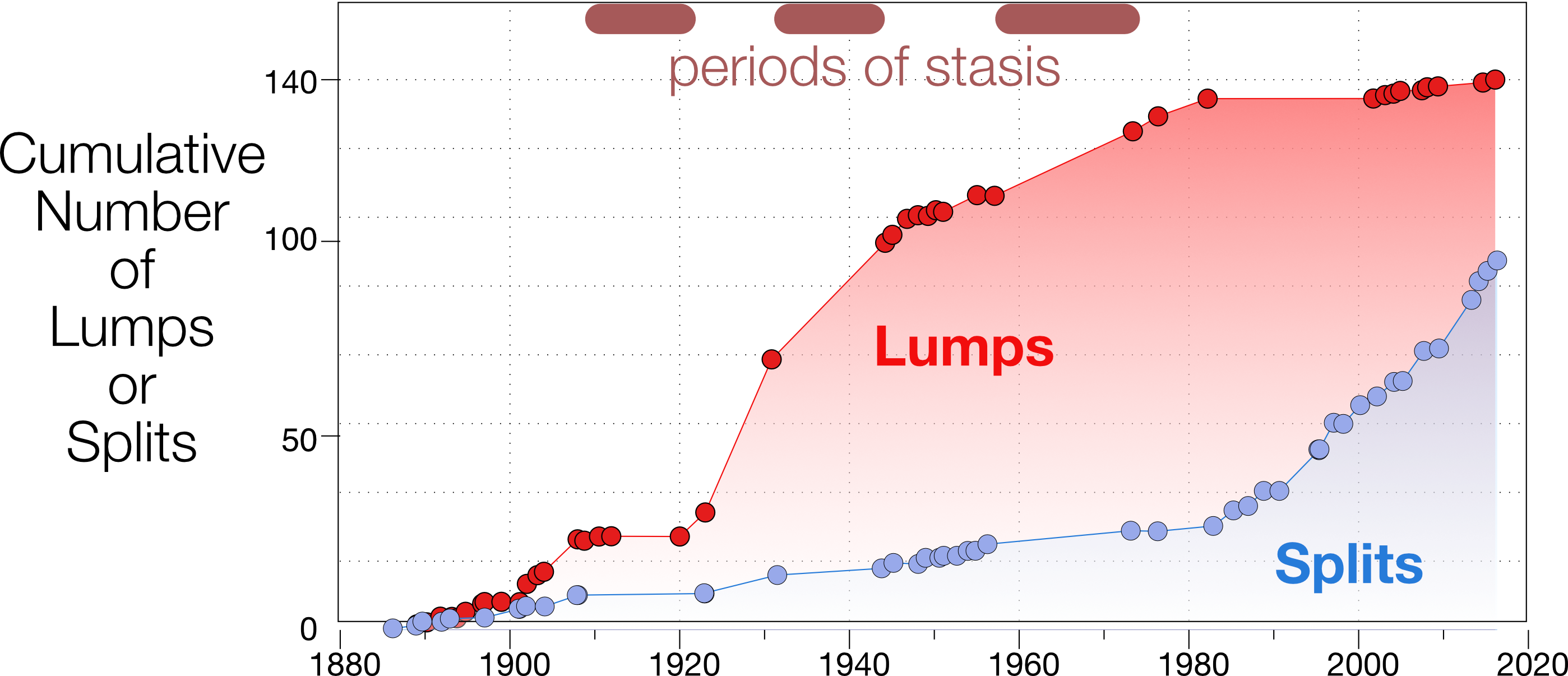Almost everyone I know who is interested in birds has their favourite group, and the reasons for those favourites vary widely. For some, the difficulty—and their mastery—of field identification is most appealing: I am thinking peeps, LBJ sparrows, fall wood warblers in North America and leaf (Phyloscopus) warblers in Europe. For others, it’s the beauty of—variously—their songs (wood warblers, thrushes, mimics), their plumages (male wood warblers in spring, hummingbirds, trogons, peafowl), their ability to fly (falcons, hummingbirds, swallows, swifts), their intelligence (corvids, tits, parrots), or their way of life (seabirds, hummingbirds, waterfowl, shorebirds, antbirds, brood parasites, cooperative breeders, lekking species, owls).

For many scientists, their favourites are the birds that they have studied most—often as much by accident as by design. Among my ornithologist friends and colleagues, the favourites are coots, murres, manakins, Parids, fairy wrens, acorn woodpeckers, barn swallows, anis, and snow geese. My own favourites are hummingbirds (PhD research), shorebirds and ptarmigan (20 years of arctic research), and seabirds (summer job before PhD).
When I began birding, however, my favourites were the Hylocichla (now Catharus) thrushes and the Empidonax flycatchers, possibly because some species were hard to identify. I was also intrigued by the geographic mosaic of Empidonax ranges and the incredible similarities in their plumages described by Ned Johnson, among others. Why is it that some species in some genera (Dendroica males in spring, for example) are so easy to tell apart whereas in other genera (like Empidonax) species can only be distinguished morphologically by careful measurements of a bird in the hand (or so we thought). My own careful examination of Empidonax flycatchers while banding them at Long Point Bird Observatory resulted my first paper in an international journal more than 50 years ago.

Because of that early interest in the Empidonax flycatchers, I was both dismayed and intrigued when the AOU split the Traill’s Flycatcher into two species—Alder and Willow—in 1973 on the basis of their song and some morphological traits. Here was a species that I thought I knew well (albeit only on migration), that was actually two species, even more cryptic than the other hard-to-tell-apart species in that genus. This was my first lesson in the fluidity of taxonomy and the possibility that there were almost certainly other cryptic species to be found. I remember wondering, for example, if the Grey-cheeked Thrush might be two species, based on the obvious morphological and geographic differences in the subspecies bicknelli, and that, too, was formally recognized as a separate species by the AOU in 1995.
Throughout the 20th century, there was often a tension between lumpers and splitters [1] when it came to avian taxonomy. Some suggested that the differences between splitting and lumping were like the differences between liberal and conservative governments in democracies. We now recognize, however, that periods of lumping and splitting are the result of changing opinions about species definitions, and the progress of technologies that allow us to distinguish among populations.
A new paper in PLoS ONE by Gaurav Vaidya, Denis Lepage, and Robert Guralnick [2] uses the 136 years of AOU checklists to examine, among other things, the historical patterns of lumping and splitting of the North American avifauna by taxonomists. The first AOU checklist was published in 1886, the production of which was one of the stated reasons for the for the formation of the American Ornithologists’ Union in 1883. Since then, 6 additional full ‘editions’ of the checklist have been published, with 57 supplements published at roughly 2-year intervals between editions.
Since 1886, fully three-quarters of the ~900 North American species have not been involved in what the authors call the ‘correction process’, being either lumped with other species or split into two or more species by the checklist committees. Sixteen percent have been corrected once, and the remaining 10% twice or more. In all, there have been more lumps (142) than splits (95) in the past 130 years but the pattern of change has been striking. Lumping was initially the norm, probably largely due to the widespread adoption of the Biological Species Concept. But very few species have been lumped since 1980 as the rate of splitting took off, likely because DNA technologies improved and there began a (slight) shift toward a phylogenetic species concept.

Their analysis identified three periods of relative stasis, when there were no corrections to be made, perhaps roughly coinciding with periods of societal upheaval and dramatic scientific changes in taxonomic philosophies and practices.
Vaiyda and colleagues also identify some intriguing examples of “… a current, ongoing taxonomic recorrection process, in which corrections made in the first half of the 20th century are now being reverted in light of new evidence and better tools. [3]. To the non-scientist this must look like the taxonomists are incredibly indecisive but these recorrections actually (often) reflect the sort of changes in species definitions and technologies described above. For example, in 1923 the Common Galllinule (Gallinula galeata) of North America was lumped with the Common Moorhen (Gallinula chloropus) of Europe because they were thought, based on their breeding ranges and morphologies, to be subspecies. Then, in 2011, those species were split again, recognizing the differences in their vocalizations, bill and shield morphologies, and mtDNA.

If the trend shown in the graph continues—and there is no reason to expect that it will not—the number of splits will soon surpass the number of lumps. Recently, George Barrowclough and colleagues have speculated that the level of splitting resulting from the application of genomic tools and the phylogenetic species concept will almost double the number of species recognized worldwide—to 18,000—before too long. The implications of this for conservation, for understanding the evolutionary history of birds, and for my life list, are huge.
SOURCES
-
American Ornithologists’ Union. 1995. Fortieth supplement to the American Ornithologists’ Union Check-list of North American Birds. Auk 112: 819-830.
- Barrowclough GF, Cracraft J, Klicka J, Zink RM (2016) How many kinds of birds are there and why does it matter? PLoS One. 2016; 11: e0166307. https://doi.org/10.1371/journal.pone.0166307 PMID: 27880775
- Chesser RT, Banks RC, Barker FC, Cicero C, Dunn JL, Kratter AW, Lovette IJ, Rasmussen PC, Remsen Jr JV, Rising JD, Stotz DF, Winker K. (2011) Fifty-Second Supplement to the American Ornithologists’ Union Check-List of North American Birds. Auk 128: 600-613
-
Johnson NK (1980) Character variation and evolution of sibling species in the Empidonax difficilis-flavescens complex (Aves: Tyrannidae). University of California Publications in Zoology 112: 1-151.
-
Mayr E (1982) The Growth of Biological Thought. Cambridge, Mass: Belknap Press.
-
Stone W, Oberholser HC, Dwight J, Palmer TS, Richmond CW (1923) Eighteenth Supplement to the American Ornithologists’ Union Check-List of North American Birds. Auk 40:513–525.
-
Vaidya G, Lepage D, Guralnik R (2018) The tempo and mode of the taxonomic correction process: How taxonomists have corrected and recorrected North American bird species over the last 127 years. PLoS ONE 13(4): e0195736. https:// doi.org/10.1371/journal.pone.0195736
Footnotes
- lumpers and splitters: respectively, taxonomists who favour placing similar populations under the umbrella of a single species versus those who seek to identify distinct populations as separate species. Ernst Mayr (1982, page 240) claimed that “As a general rule one can say that most taxonomic groups pass through a phase of rather intensive splitting when they are studied more actively, but that the splitting phase is reversed when the knowledge of the group reaches greater maturity.” I think this new paper by Vaidya et al. (2018) shows that statement to be incorrect and may reflect Mayr’s view that his Biological Species Concept was sacrosanct.
- while this is an excellent analysis the paper is technically detailed, a necessity given the changes in the way species have been defined and the changes in coverage of the checklist. I have tried to distill some of those details here but I am no taxonomist.
- quotation: from Vaidya et al (2018 page 2)
IMAGES: peeps by the author; graph redrawn by the author from Vaidya et al (2018, Figure 1); Flycatchers from https://u.osu.edu/biomuseum/2015/09/28/examples-of-sibling-species/comment-page-1/; Gallinula spp. from Wikimedia Commons, in the public domain.
COMMENTS